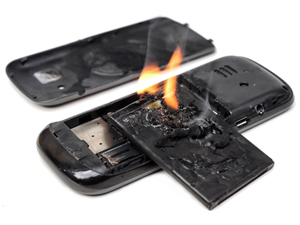



Date:17/01/17
 Exploding batteries in smartphones are not uncommon. Due to various factors, including high capacity in a compact size, lithium-ion battery occurs short circuit or overheating, therefore the liquid inside can evaporate and ignite. To solve this problem, scientists at Stanford University in California have invented a mini-fire extinguishers, batteries.
Exploding batteries in smartphones are not uncommon. Due to various factors, including high capacity in a compact size, lithium-ion battery occurs short circuit or overheating, therefore the liquid inside can evaporate and ignite. To solve this problem, scientists at Stanford University in California have invented a mini-fire extinguishers, batteries.
One way to avoid the explosion is to add flame retardant in the liquid inside the battery acting as the electrolyte. But in this case, the reduced conductivity of the electrolyte and the battery performance. Scientists from Stanford has offered to put a flame retardant in a special capsule made of polymer, which separates it from the electrolyte. In this case, retains all the properties of the battery, and in the case of overheating or fire sheath flame retardant melts, and he puts out the fire.
During the tests the flame retardant capsule very quickly melted in the burning electrolyte and immediately extinguished it. The whole process takes less than a half second. And most importantly, during testing of the developments in commercial batteries, their properties and performance does not suffer. However, scientists have discovered that after 360 cycles of discharging and charging a small amount of flame retardant still permeates through the capsule wall into the electrolyte, which eventually reduces the performance of the battery. Now researchers are working on a solution to this problem.
One of the areas where this technology can be electric cars, because they use large batteries to overheat which can lead to a fatal outcome. Experts say that for use in vehicles such capsules must remain in working condition for 10 or 20 years.
Scientists created flame-resistant batteries
 Exploding batteries in smartphones are not uncommon. Due to various factors, including high capacity in a compact size, lithium-ion battery occurs short circuit or overheating, therefore the liquid inside can evaporate and ignite. To solve this problem, scientists at Stanford University in California have invented a mini-fire extinguishers, batteries.
Exploding batteries in smartphones are not uncommon. Due to various factors, including high capacity in a compact size, lithium-ion battery occurs short circuit or overheating, therefore the liquid inside can evaporate and ignite. To solve this problem, scientists at Stanford University in California have invented a mini-fire extinguishers, batteries.One way to avoid the explosion is to add flame retardant in the liquid inside the battery acting as the electrolyte. But in this case, the reduced conductivity of the electrolyte and the battery performance. Scientists from Stanford has offered to put a flame retardant in a special capsule made of polymer, which separates it from the electrolyte. In this case, retains all the properties of the battery, and in the case of overheating or fire sheath flame retardant melts, and he puts out the fire.
During the tests the flame retardant capsule very quickly melted in the burning electrolyte and immediately extinguished it. The whole process takes less than a half second. And most importantly, during testing of the developments in commercial batteries, their properties and performance does not suffer. However, scientists have discovered that after 360 cycles of discharging and charging a small amount of flame retardant still permeates through the capsule wall into the electrolyte, which eventually reduces the performance of the battery. Now researchers are working on a solution to this problem.
One of the areas where this technology can be electric cars, because they use large batteries to overheat which can lead to a fatal outcome. Experts say that for use in vehicles such capsules must remain in working condition for 10 or 20 years.
Views: 538
©ictnews.az. All rights reserved.Similar news
- The mobile sector continues its lead
- Facebook counted 600 million active users
- Cell phone testing laboratory is planned to be built in Azerbaijan
- Tablets and riders outfitted quickly with 3G/4G modems
- The number of digital TV channels will double to 24 units
- Tax proposal in China gets massive online feedback
- Malaysia to implement biometric system at all entry points
- Korea to build Green Technology Centre
- Cisco Poised to Help China Keep an Eye on Its Citizens
- 3G speed in Azerbaijan is higher than in UK
- Government of Canada Announces Investment in Green Innovation for Canada
- Electric cars in Azerbaijan
- Dominican Republic Govt Issues Cashless Benefits
- Spain raises €1.65bn from spectrum auction
- Camden Council boosts mobile security





















